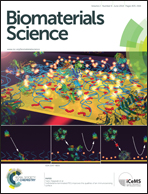Development of a surface to enhance the effectiveness of fibroblast growth factor 2 (FGF-2)†
Abstract
Growth factors (GFs) play an important role in biological processes such as cell proliferation, differentiation and angiogenesis. GFs are known to bind to glycosaminoglycans (GAGs) in the extracellular matrix, aiding projection from degradation and pooling the GFs for quick response to biological stimuli in vivo. GFs are typically expensive and have a relatively short half-life in culture media, requiring regular replenishment. Here the cooperative binding of GF to a plasma polymerised surface decorated with heparin, and the subsequent culture of primary human dermal fibroblasts (HDFs) is investigated. A simple one-step technique suitable for coating a wide range of different substrates was utilised. Substrates such as culture-ware, scaffolds, bandages and devices for implantation could be coated. The modified surface was compared to standard culture techniques of addition of GF to the media. Results demonstrate that surface bound heparin and FGF-2 have a greater effect on cell proliferation especially at reduced serum concentrations. With performance equivalent to supplementing the media achieved at as little as 1% total FGF-2 added. The protective cooperative effect of FGF-2-GAG bound to modified surface at the interface could lead to reduced costs by reduction of FGF-2 required. Furthermore, for applications such as chronic non-healing wounds, bandages can be produced modified by plasma and decorated with GAGs that could utilise and protect important GFs. This would effectively re-introduce important biomolecules which are protected by GAG binding into a harsh environment.


 Please wait while we load your content...
Please wait while we load your content...